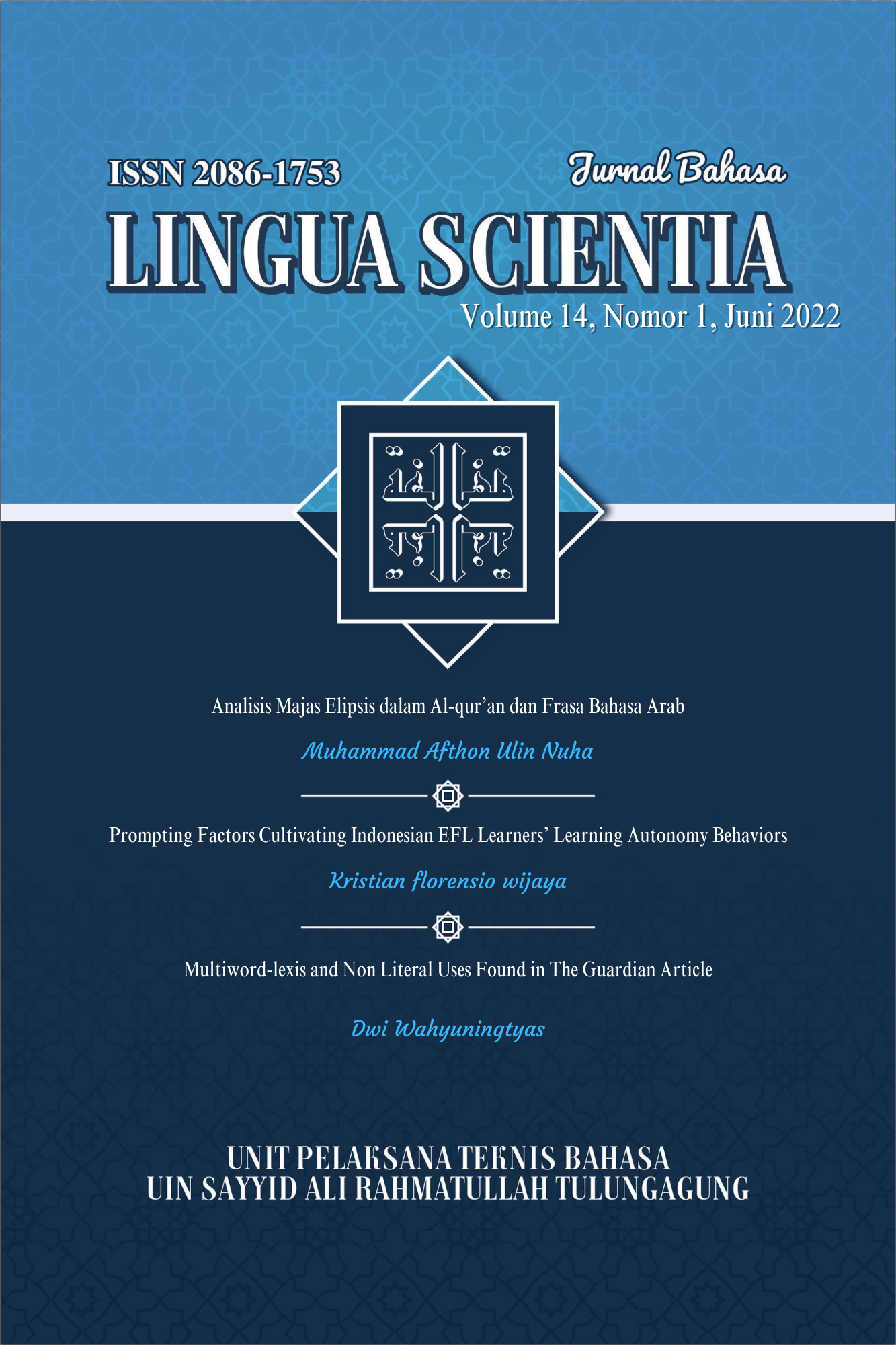ISLAMIC BOARDING SCHOOL STUDENTS’ LEARNING STYLES IN EFL CLASS
Abstract
Abstract:
The students sometimes get confused with the English material because their learning style does not match with the presentation of the teacher. the learning styles need be known by teachers involved in teaching and learning process. This research aims to disclose students' needs for learning English based on their learning styles. This research used quantitative research with survey research methods. The research was conducted on second grade students of MA in three Islamic boarding schools in the city of Parepare, South Sulawesi, Indonesia. The instrument in this study is a questionnaire containing the Perceptual Learning Style Preferences Questionnaire consisting of Visual, Auditory. Kinesthetics, Tactile, Group and Individual Styles. This research discloses that students have more kinesthetics, auditory, visual, and group learning styles. It found that students’ learning styles are major in visual, auditory, kinesthetics, and group learning styles. Meanwhile, some of the students in Boarding School of Parepare are minor in tactile and individual learning styles. Therefore, the teacher should make teaching materials based on the learning style of each student.
Downloads
References
Abdollahzadeh, E., & Naser, A. (2010). The Effect of Vocabulary Instruction through Semantic Mapping among EFL Learners with Different Perceptual Learning Styles. The Effect of Semantic Mapping as a Vocabulary Instruction Technique on EFL Learners with Different Perceptual Learning Styles, 1(2).
Abidin, M. J. Z., Rezaee, A. A., Abdullah, H. N., & Singh, K. K. B. (2011). Learning Styles and Overall Academic Achievement in a Specific Educational System. International Journal of Humanities and Social Science, 1(10).
Al-Hamlan, S., & Abdelrahman, A. (2015). A Needs Analysis Approach to EFL Syllabus Development for Second Grade Students in Secondary Education in Saudi Arabia : A Descriptive Analytical Approach to Students ’ Needs. American International Journal of Contemporary Research, 5(1).
Arifin, Z. (2015). Teaching And Learning English Paradigm And The Implementation Of The Policy. Register Journal, 8(1), 19–44. https://doi.org/10.18326/rgt.v8i1.19-44
Cegielski, C. G., Hazen, B. T., & Rainer, R. K. (2011). Teach Them How They Learn: Learning Styles and Information Systems Education. Journal of Information Systems Education, 22(2).
Davidman, L. (1981). Learning Style: The Myth, the Panacea, the Wisdom. The Phi Delta Kappan, 62(9), 641–645.
De Porter, B., & Hernacki, M. (1992). Quantum Learning. PT Mizan Publika.
Fatt, J. P. T. (2000). Understanding the learning styles of students: implications for educators. International Journal of Sociology and Social Policy, 20(11).
Harefa, K., & Indrawati, E. S. (2014). Perbedaan Perilaku Pro sosial Siswa Madrasah Aliyah (MA) Berbasis Pondok Pesantren Dan Sekolah Menengah Umum (SMU). Empati, 3(3).
Honey, P., & Mumford, A. (1992). The manual of learning styles. Peter Honey Publication.
Ismail, W. (2009). Analisis Komparatif Perbedaan tingkat religiusitas siswa di lembaga pendidikan pesantren, MAN, dan SMUN. Lentera Pendidikan: Jurnal Ilmu Tarbiyah Dan Keguruan, 12(1), 87–102.
Kaur, J., Rana, J. S., & Kaur, R. (2009). Home Environment and Academic Achievement as Correlates of Self-concept among Adolescents. Studies on Home and Community Science, 3(1). https://doi.org/10.1080/09737189.2009.11885270
Li, J. (2014). Needs Analysis: An Effective Way in Business English Curriculum Design. Theory and Practice in Language Studies, 4(9). https://doi.org/10.4304/tpls.4.9.1869-1874
Lohri-Posey, B. (2003). Determining learning style preferences of students. Nurse Educator, 28(2). https://doi.org/10.1097/00006223-200303000-00002
Manochehri, N. N., & Young, J. I. (2006). the Impact of Student Learning Styles With Web-Based Learning or Instructor-Based Learning on Student Knowledge and Satisfaction. Quarterly Review of Distance Education, 7(3).
McLoughlin, C. (1999). The implications of the research literature on learning styles for the design of instructional material. Australasian Journal of Educational Technology, 15(3). https://doi.org/10.14742/ajet.1859
Poon Teng Fatt, J. (2000). Understanding the learning styles of students: Implications for educators. In International Journal of Sociology and Social Policy (Vol. 20, Issues 11–12). https://doi.org/10.1108/01443330010789269
Pozuelos Estrada, F. J., García-Prieto, F. J., & Conde-Vélez, S. (2020). Learning styles in university students: Types of strategies, materials, supports, evaluation and performance. Case study. European Journal of Contemporary Education, 9(2). https://doi.org/10.13187/ejced.2020.2.394
Razawi, N. ., Mazni, M., Sulia Masturina, C. R., Norhayati, H., & Nor Zaitolakma, A. S. (2011). Students’ Diverse Learning Styles in Learning English As A Second Language. International Journal of Business and Social Science, 2(19).
Reid, J. M. (1987). The learning style preferences of EFL students. TESOL Quarterly, 21(1), 87–111.
Zainal Abidin, M., Aceng Rahmat, & Zuriyati. (2020). English Learning Model: An Ethnography Study. Getsempena English Education Journal, 7(1). https://doi.org/10.46244/geej.v7i1.1059
Copyright (c) 2022 Kalsum Kalsum

This work is licensed under a Creative Commons Attribution-NonCommercial 4.0 International License.
Before going to review process, all manuscripts will be checked that they are free from plagiarism practice using "Turnitin" software. If there is an indication of plagiarism, the manuscript will instantly be rejected.


